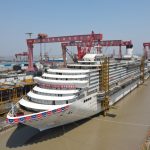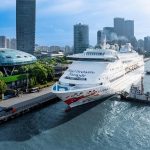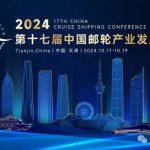As temperatures rise across the country, the peak travel season has quietly arrived. While county-level tourism, cultural heritage tours, and outbound travel have become hot trends in the tourism industry, the once niche cruise tourism sector is also quietly emerging.
Public data shows that during this year’s Spring Festival travel season, cruise passenger volume reached 172,000, a year-on-year increase of 145.6%. During the May Day holiday, Shanghai’s cruise port saw a spectacular “four ships docking” scene, with nearly 30,000 inbound and outbound passengers in a single day—a new high in the past three years.
Amid this market heat, cruise brands are already gearing up. To seize the opportunity of the travel peak season, many cruise lines are turning their attention to new cultural crossover strategies—offering themed travel products tied to traditional culture such as intangible heritage, Hanfu, and even commercial IPs like Nezha and LEGO. These cultural crossovers are leading the cruise economy into a new blue ocean.
Cruise Tourism: After the Price Wars Comes the Cultural Battle
Although the impressive data since the start of 2025 has raised expectations for the “cruise economy,” cruises remain a niche travel choice in the Chinese market. Historically, cruise travel has focused on core selling points like ocean sightseeing, onboard entertainment, specialty dining, and duty-free shopping. This model met the basic needs of mainstream consumers during the market’s early cultivation phase.
However, as China’s cruise market matures, homogenization has become a bottleneck. Nearly identical services and overlapping Japan-Korea routes have eroded competitive differentiation, failing to meet the new generation’s demand for unique experiences.
The trend in outbound tourism supports this shift. According to the China Outbound Tourism Development Annual Report 2024 by the China Tourism Academy, outbound travel reached 146 million trips in 2024, nearing pre-pandemic levels and displaying increasing destination diversity. Chinese tourists visited over 210 countries or regions that year. Survey data reveals that scenic appeal and cultural differences are major factors influencing destination choices.
At the same time, changes in consumption patterns are putting additional pressure on the cruise industry. Travelers are becoming more price-sensitive. In response, cruise lines launched price cuts. During the 2024 summer season, China’s cruise market saw a wave of steep discounts—some routes slashed prices by 30–60%, with companies losing millions in a single season.
After the price collapse, major cruise operators like Royal Caribbean, MSC Cruises, and Adora Cruises began offering lower pricing, limited-time discounts (e.g., “third and fourth guest sail free”), and value-added services like free Wi-Fi to encourage early bookings. But for a capital-intensive industry, relying solely on pricing is unsustainable. Long-term success depends on increasing product value.
That’s where cultural crossovers come in—as a key strategy for brands to reignite market interest.
Cultural IP Crossovers: The New Growth Engine for Tourism
In recent years, cultural IP has played an increasingly important role in boosting tourism. From the commercialization of the Palace Museum IP, the global success of the domestic AAA video game “Black Myth: Wukong” driving attention to Shanxi’s ancient architecture, to the blockbuster “Nezha 2” that brought a surge of interest to myth-themed sites in Tianjin and Sichuan—culture has proven it can activate consumer demand and create premium value in tourism.
Cruise brands have picked up on this trend.
Since 2024, both domestic and international cruise lines have ramped up efforts in cultural crossovers:
Adora Magic City launched cruises themed around folk songs, tea culture, and even the first sea-based book festival, weaving Chinese culture into brand experiences.
MSC Bellissima partnered with Chinese cultural figures to offer a “Sinology” cruise featuring traditional Chinese studies, Hanfu, and intangible heritage.
CM-Yidun launched a “Discover China” cruise route for international travelers, combining stops at Zhoushan, Dongtou, Pingtan, and Xiamen with onshore cultural experiences.
Blue Dream Star started a 33-night voyage retracing Zheng He’s maritime expeditions, recreating an epic historical journey.
These cultural crossovers enrich the cruise experience with depth and context, creating new consumer scenarios and business opportunities.
Family Travel: A Crucial Market Segment
Every summer, family and parent-child travel becomes a hot topic in the tourism market. Compared to short holidays, the longer summer break provides ideal conditions for family trips. According to Ctrip’s 2024 Summer Travel Market Report, family travelers accounted for 35% of total bookings. Notably, study tours increased by 175% year-on-year, with domestic participants doubling and international study tour travelers up by 120%.
Tongcheng Travel’s 2024 Summer Tourism Trend Report highlighted that historical and cultural cities remain top destinations for family travel, with museums especially popular.
This shift reflects how modern parents now seek a balance between fun and educational value. Cruises—offering unique spatial and temporal advantages—are well-positioned to meet this need through cultural crossovers.
To align with the “edutainment” philosophy of modern parenting, cruise products have undergone major upgrades. Beyond traditional water parks and play zones, cruise companies now offer educational travel products, transforming cruises into floating cultural learning platforms.
Examples include:
Adora Magic City during the Dragon Boat Festival offered interactive family stage shows like The Classic of Mountains and Seas, children’s sailing programs, and a digital art exhibition on Dunhuang culture with audio guides.
For summer 2025, the same ship launched a Nezha-themed voyage featuring stage plays, film screenings, character parades, interactive games, and themed cabins—creating a full-scale immersive cultural experience at sea.
MSC Bellissima upgraded its LEGO-themed experience with sea-based master classes exploring aerospace, marine life, and seasonal themes. Children receive certificates upon completing the program, adding a study-tour component.
Royal Caribbean’s Spectrum of the Seas partnered with early education brand Qiaohu, offering themed cabins, character breakfasts, and special parties to create unforgettable family moments.

Can Niche Cruise Tourism Go Mainstream?
Though the Chinese cruise market is clearly recovering, cruise tourism still lags behind more established travel forms. Globally, while the cruise industry has a history of nearly 200 years, modern cruise tourism has only boomed in the past 50 years. In China, the sector remains in its infancy.
Taking the arrival of Costa’s Allegra in Shanghai in 2006 as a starting point, the domestic market has less than 20 years of history. The first large-scale domestic cruise ship—Adora Magic City—only began operating on January 1, 2024.
Pop culture depictions in films like Titanic and The Legend of 1900 shaped public imagination around cruises. Many dream of a cruise vacation, yet few have actually experienced one. On social media, cruise travel content is noticeably scarcer compared to other travel forms—showing a gap in awareness and acceptance.
Several reasons explain this:
High costs – Even discounted tickets often start at 2,000 yuan per person. For a more comfortable experience, costs easily rise above 5,000 yuan. Given current economic conditions, this prices out many potential consumers. On platforms like Xiaohongshu, hashtags like #CruiseLastMinute and #CruiseDeals have over 2 million views—highlighting demand for bargains.
Inconsistent experience – Complaints are common: long boarding queues, crowded restaurants with slow service, disorganized port transfers, and underwhelming shore excursions. Price drops have also led to dissatisfaction among early bookers, creating negative word-of-mouth.
Culture Is Not a Sticker: Depth, Design, and Differentiation Are Key
Cultural crossovers have brought new attention to the cruise sector and offer a market-savvy way to refresh the product. For example, the success of “theme-based tourism” in various cities shows how integrating culture can boost appeal.
One example cited by Jingzhe Research is Xunpu Village in Quanzhou, Fujian. With fewer than 10,000 residents, the village attracted over 430,000 visitors during the Spring Festival thanks to its intangible heritage of traditional flower hairpins.
Similarly, the 2025 Shanghai Cruise Cultural Tourism Festival featured new cruise products, immersive port activities, and local cultural collaborations—developing the “cruise economy” into a regional specialty industry.
But cultural crossover must go beyond simple labeling. True breakthroughs in cruise tourism require:
Thoughtful experience design with organically integrated cultural elements,
Smooth cultural transitions, especially for onshore activities,
Ongoing product and route innovation to avoid fatigue and sameness.
And a critical warning: if every cruise line adopts cultural themes without distinction, the sector may face a new round of homogenization. Once the novelty wears off, service quality will again be the deciding factor.
Only by making parallel progress in cultural innovation and service enhancement can cruise tourism break out of its niche and truly enter the mainstream.







